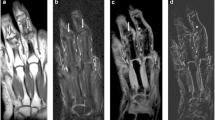Abstract
Key messages
No difference between both hands was observed for clinical and radiographical presentations in EHOA patients.
A bilateral and symmetrical relationship was found between hand joints.
Highlights
EHOA have symmetrical distribution and specific association in structural lesions.
Abstract
This study aims to analyse the preferential topographical distribution of clinical and structural lesions between the dominant and non-dominant hands in erosive hand osteoarthritis (EHOA) patients. Both hands were assessed via radiography in EHOA patients. A comparative analysis of the clinical features and structural lesions between the dominant and non-dominant hands was performed. The structural lesions were assessed according to the anatomical radiographic score of Verbruggen-Veys (VV). Next, a principal component analysis was performed to describe and highlight the relationships observed between the joints. Sixty patients were included in this study: there were 57 women, and the mean age was 66.1 (± 7.6) years. For the distal interphalangeal (DIP) joints, nodes were observed more frequently on the dominant hand (4 vs 3; p = 0.005). No difference in structural lesions was observed between the two hands except for the 2nd proximal interphalangeal (PIP) (p = 0.045). A principal component analysis with varimax rotation described relationships between the 2nd PIP, 3rd PIP, 4th PIP, 4th DIP and 5th DIP joints in both hands. No significant differences between dominant and non-dominant hands were observed for clinical and structural lesions in our sample of EHOA patients. A bilateral and symmetrical injury was observed in most EHOA joints.
Trial registration Clinical trial registration number: NCT01068405.

Similar content being viewed by others
References
Haugen IK, Slatkowsky-Christensen B, Bøyesen P et al (2013) Cross-sectional and longitudinal associations between radiographic features and measures of pain and physical function in hand osteoarthritis. Osteoarthritis Cartilage 21:1191–1198. https://doi.org/10.1016/j.joca.2013.04.004
Slatkowsky-Christensen B, Mowinckel P, Loge JH, Kvien TK (2007) Health-related quality of life in women with symptomatic hand osteoarthritis: a comparison with rheumatoid arthritis patients, healthy controls, and normative data. Arthritis Rheum 57:1404–1409. https://doi.org/10.1002/art.23079
Marshall M, Watt FE, Vincent TL, Dziedzic K (2018) Hand osteoarthritis: clinical phenotypes, molecular mechanisms and disease management. Nat Rev Rheumatol 14:641–656. https://doi.org/10.1038/s41584-018-0095-4
Nakamura R, Ono Y, Horii E et al (1993) The aetiological significance of work-load in the development of osteoarthritis of the distal interphalangeal joint. J Hand Surg 18:540–542. https://doi.org/10.1016/0266-7681(93)90167-E
Hadler NM, Gillings DB, Imbus HR et al (1978) Hand structure and function in an industrial setting. Arthritis Rheum 21:210–220. https://doi.org/10.1002/art.1780210206
Lane NE, Bloch DA, Jones HH et al (1989) Osteoarthritis in the hand: a comparison of handedness and hand use. J Rheumatol 16:637–642
Marshall M, Nicholls E, Kwok W-Y et al (2015) Erosive osteoarthritis: a more severe form of radiographic hand osteoarthritis rather than a distinct entity? Ann Rheum Dis 74:136–141. https://doi.org/10.1136/annrheumdis-2013-203948
Haara MM (2003) Osteoarthritis of finger joints in Finns aged 30 or over: prevalence, determinants, and association with mortality. Ann Rheum Dis 62:151–158. https://doi.org/10.1136/ard.62.2.151
Bijsterbosch J, van Bemmel JM, Watt I et al (2011) Systemic and local factors are involved in the evolution of erosions in hand osteoarthritis. Ann Rheum Dis 70:326–330. https://doi.org/10.1136/ard.2010.138230
Haugen IK, Englund M, Aliabadi P et al (2011) Prevalence, incidence and progression of hand osteoarthritis in the general population: the Framingham Osteoarthritis Study. Ann Rheum Dis 70:1581–1586. https://doi.org/10.1136/ard.2011.150078
Egger P, Cooper C, Hart DJ et al (1995) Patterns of joint involvement in osteoarthritis of the hand: the Chingford Study. J Rheumatol 22:1509–1513
Fioravanti A, Cheleschi S, De Palma A et al (2018) Can adipokines serum levels be used as biomarkers of hand osteoarthritis? Biomarkers 23:265–270. https://doi.org/10.1080/1354750X.2017.1401665
Hussain S, Sivakumaran P, Gill A et al (2018) Ultrasonography-detected subclinical inflammation in patients with hand osteoarthritis and established rheumatoid arthritis: a comparison between two different pathologies using the same ultrasound examination protocol. Musculoskeletal Care 16:26–31. https://doi.org/10.1002/msc.1197
Haugen IK, Slatkowsky-Christensen B, Bøyesen P et al (2016) MRI findings predict radiographic progression and development of erosions in hand osteoarthritis. Ann Rheum Dis 75:117–123. https://doi.org/10.1136/annrheumdis-2014-205949
Mancarella L, Addimanda O, Pelotti P et al (2015) Ultrasound detected inflammation is associated with the development of new bone erosions in hand osteoarthritis: a longitudinal study over 3.9 years. Osteoarthritis Cartilage 23:1925–1932. https://doi.org/10.1016/j.joca.2015.06.004
Mancarella L, Addimanda O, Meliconi CC and Meliconi R (2017) Synovial inflammation drives structural damage in hand osteoarthritis: a narrative literature review. In: Current rheumatology reviews. http://www.eurekaselect.com/145495/article. Accessed 14 Nov 2019
Roux CH, Foltz V, Maheu E et al (2016) MRI and serum biomarkers correlate with radiographic features in painful hand osteoarthritis. Clin Exp Rheumatol 34:991–998
Segal R, Avrahami E, Lebdinski E et al (1998) The impact of hemiparalysis on the expression of osteoarthritis. Arthritis Rheum 41:2249–2256. https://doi.org/10.1002/1529-0131(199812)41:12%3c2249::AID-ART21%3e3.0.CO;2-O
Funding
This work was supported by a grant from the Clinical Research Hospital Program from the French Ministry of Health obtained by Pr Christian Roux. We are grateful to Alain Canagas for the graphical work.
Author information
Authors and Affiliations
Corresponding author
Additional information
Publisher's Note
Springer Nature remains neutral with regard to jurisdictional claims in published maps and institutional affiliations.
Rights and permissions
About this article
Cite this article
Allado, E., Wittoek, R., Albuisson, E. et al. Topographical analysis of structural lesions between dominant and non-dominant hands in erosive osteoarthritis. Rheumatol Int 41, 617–623 (2021). https://doi.org/10.1007/s00296-020-04784-1
Received:
Accepted:
Published:
Issue Date:
DOI: https://doi.org/10.1007/s00296-020-04784-1




